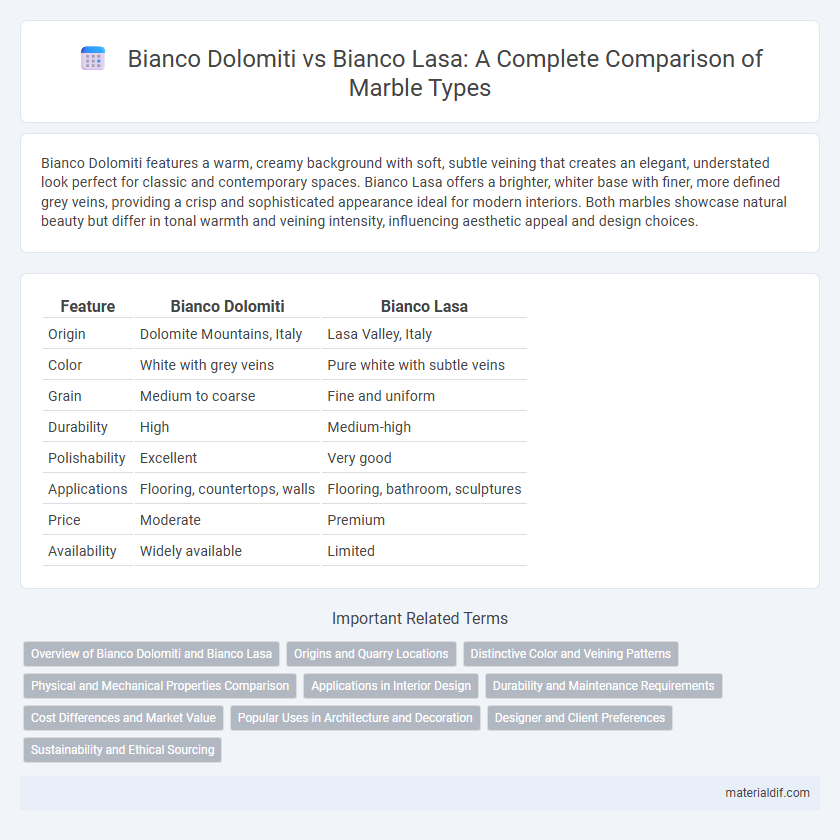Bianco Dolomiti features a warm, creamy background with soft, subtle veining that creates an elegant, understated look perfect for classic and contemporary spaces. Bianco Lasa offers a brighter, whiter base with finer, more defined grey veins, providing a crisp and sophisticated appearance ideal for modern interiors. Both marbles showcase natural beauty but differ in tonal warmth and veining intensity, influencing aesthetic appeal and design choices.
Table of Comparison
| Feature | Bianco Dolomiti | Bianco Lasa |
|---|---|---|
| Origin | Dolomite Mountains, Italy | Lasa Valley, Italy |
| Color | White with grey veins | Pure white with subtle veins |
| Grain | Medium to coarse | Fine and uniform |
| Durability | High | Medium-high |
| Polishability | Excellent | Very good |
| Applications | Flooring, countertops, walls | Flooring, bathroom, sculptures |
| Price | Moderate | Premium |
| Availability | Widely available | Limited |
Overview of Bianco Dolomiti and Bianco Lasa
Bianco Dolomiti marble is characterized by its pure white background with subtle grey veining, sourced primarily from the Dolomite mountains in Northern Italy, making it ideal for elegant interiors and countertops. Bianco Lasa marble, quarried near Lasa Valley, features a finer grain and a more homogeneous white tone with delicate grey streaks, prized for its uniformity and ease of polishing. Both marbles offer distinct aesthetic qualities, with Bianco Dolomiti showcasing natural veining patterns and Bianco Lasa providing a cleaner, more refined appearance.
Origins and Quarry Locations
Bianco Dolomiti marble originates from quarries located in the Dolomite Mountains of northern Italy, characterized by its bright white background with subtle gray veining. In contrast, Bianco Lasa marble is quarried in the Lasa Valley in South Tyrol, known for its pure white color and fine-grained texture. The distinct geological formations of these quarry locations contribute to the unique aesthetic and physical properties of each marble type.
Distinctive Color and Veining Patterns
Bianco Dolomiti marble features a bright white base with subtle gray veining, creating a soft, elegant aesthetic ideal for minimalist interiors. In contrast, Bianco Lasa marble is characterized by a pristine white background with more pronounced, dramatic gray veins, offering a striking and luxurious appearance. These distinctive color and veining patterns make Bianco Dolomiti suitable for understated design, while Bianco Lasa stands out in bold, high-end architectural applications.
Physical and Mechanical Properties Comparison
Bianco Dolomiti marble features a high density and excellent compressive strength, making it highly resistant to wear and suitable for heavy-duty architectural applications. In contrast, Bianco Lasa marble is known for its superior homogeneity and finer grain structure, offering enhanced polishability and a higher flexural strength. Both types exhibit low porosity and impressive hardness, but Bianco Dolomiti generally outperforms Bianco Lasa in durability under mechanical stress.
Applications in Interior Design
Bianco Dolomiti marble, characterized by its subtle white background with delicate gray veining, is ideal for elegant wall cladding and sophisticated flooring in modern interiors. Bianco Lasa marble, known for its pure white hue and fine grain, excels in creating seamless countertops and minimalist bathroom designs that emphasize light and space. Both marbles offer durability and timeless beauty, making them preferred choices for luxury residential and commercial interior applications.
Durability and Maintenance Requirements
Bianco Dolomiti marble is highly durable thanks to its dense crystalline structure, making it more resistant to scratches and etching compared to Bianco Lasa. Bianco Lasa, while prized for its elegant white background and subtle veining, requires more frequent sealing and careful maintenance to prevent staining and surface damage. For high-traffic areas, Bianco Dolomiti offers superior longevity with lower upkeep demands than Bianco Lasa.
Cost Differences and Market Value
Bianco Dolomiti marble generally presents a lower cost compared to Bianco Lasa due to differences in quarry location and extraction complexity. Bianco Lasa commands a higher market value, attributed to its finer grain, consistent white hue, and greater demand in luxury interiors. The price disparity reflects both rarity and aesthetic appeal, influencing buyer preference and application choice.
Popular Uses in Architecture and Decoration
Bianco Dolomiti marble is highly favored in architectural projects for its durable, fine-grained texture, making it ideal for flooring, wall cladding, and outdoor facades, particularly in Mediterranean designs. Bianco Lasa marble, renowned for its pure white color and subtle veining, is predominantly used in interior decoration such as sculptural works, countertops, and high-end bathroom vanities, providing a luxurious and elegant finish. Both marbles are celebrated for their ability to enhance spaces with timeless beauty, but Bianco Dolomiti excels in structural applications while Bianco Lasa shines in decorative artistry.
Designer and Client Preferences
Bianco Dolomiti offers a pronounced veining pattern favored by designers seeking bold visual impact, while Bianco Lasa features a softer, more uniform white background preferred by clients desiring a minimalist and elegant aesthetic. Designers often choose Bianco Dolomiti for statement pieces and dynamic interiors, whereas Bianco Lasa appeals to clients valuing timeless sophistication and subtlety. The preference between these marbles hinges on the balance between striking texture and refined simplicity in project design.
Sustainability and Ethical Sourcing
Bianco Dolomiti marble is renowned for its sustainable extraction practices, often sourced from environmentally certified quarries that prioritize minimal ecological impact and responsible resource management. In contrast, Bianco Lasa marble is known for its commitment to ethical sourcing, with strict adherence to fair labor practices and traceability throughout the supply chain. Both marbles reflect increasing industry standards towards sustainability and ethical responsibility, but Bianco Dolomiti excels in eco-friendly quarrying, while Bianco Lasa leads in social accountability.
Bianco Dolomiti vs Bianco Lasa Infographic

 materialdif.com
materialdif.com